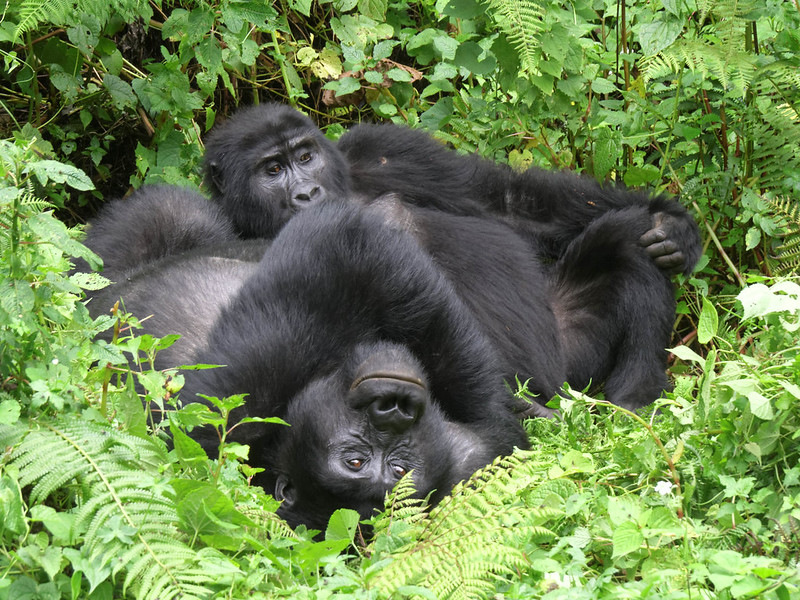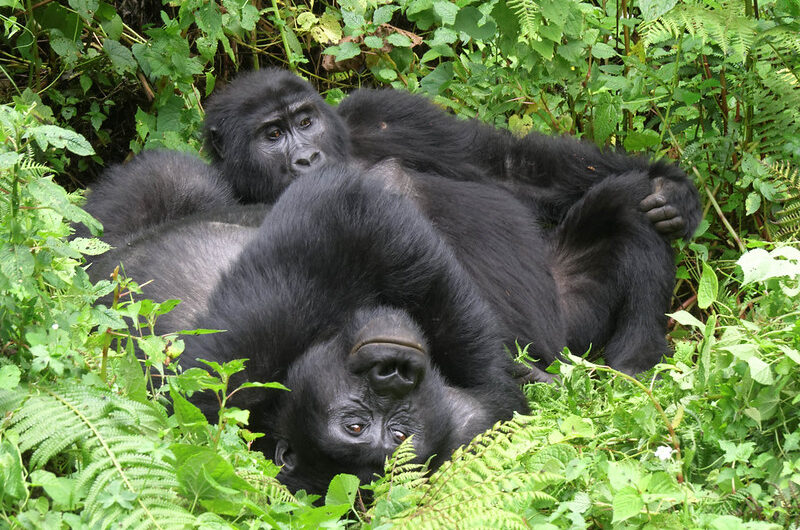Gorilla Watching in Rwanda and Uganda.
Useful tips to make sure you have a good time gorilla trekking in Rwanda.
Before embarking on your safari to track gorillas:
Be healthy and free of communicable illnesses, such as the flu or the common cold.
be at least fifteen years old.
Always wash your hands thoroughly before seeing the mountain gorillas.
Since it’s generally chilly, dress appropriately. A jacket is advised, along with a lightweight bag to hold your packed lunch and sturdy footwear to protect your ankles.
The Experience of Tracking Mountain Gorillas
A tracking crew is only allowed to consist of eight persons since any more would really disrupt the tranquility of the gorilla group you are visiting. This also reduces the amount of disease that people may spread to mountain gorillas.
You can miss out on other species and the abundance of birds in Bwindi or the Mgahinga Gorilla Park if you talk too loudly while you’re walking through this forest.
Everything you put in is packed out. Anything that is left behind, such as trash, can ruin the atmosphere for the future visitors.
Since the gorilla troop is always moving, the safari guides follow them up to their most recent position after starting the mountain gorilla viewing vacation at the spot where they last spotted them the day before.
When Mountain Gorillas Are Around
Keep a 5 m (about 15 ft) distance from the amazing mountain gorillas. By doing this, you protect the mountain gorillas from human-transmitted diseases as well as any other ailments.
When you’re with them, stay united as a team.
All voices must be kept low; it is preferable to be silent and really savor the time spent with the mountain gorillas.
Avoid consuming any food or beverages while around them.
Flash photography is prohibited. When taking photos, avoid making too many movements and maintain your composure.
Touching or even attempting to touch the gorillas is prohibited.
Until you leave the mountain gorillas’ range, keep your voice down.
Guidelines for Health
Due to their close kinship with people, mountain gorillas are particularly susceptible to human-transmitted illnesses.
Please notify the authorities if you are unwell, and avoid joining the gorilla tracking group.
To reduce the chance of infecting the gorillas, tilt your head gently away from them if you need to cough, sneeze, or blow your nose.
When among mountain gorillas, it is forbidden to smoke, drink, or eat.
Uganda
The main tourist destination in Bwindi is Buhoma, which is located north of the forest. There is a wide variety of lodging options available, and it is the trailhead for tracking three gorges. While tracking is the primary draw for tourists, there are also a variety of leisurely chances to see birds and explore Bwindi National Park, one of Uganda’s most stunning parks.
They may be scheduled to leave at 9:00 in the morning and at 14:15 in the afternoon. Reputable safari providers may arrange 3-day gorilla safaris in Bwindi, departing from Kampala or the Kigali border.
Waterfall Trail travels through one of Uganda’s largest areas of rainforest, passing under tree ferns and orchids to explore three glittering waterfalls; the Munyanga River Trail, located in the valley below Buhoma, is a great short-distance walk to observe birds and monkeys at the forest edge.
Muzabajiro Loop Trail climbs to the summit for breathtaking views of Bwindi forest, the western rift valley, and the Virunga volcanoes. River Ivi Trail follows an old road through the beaL and emerges near Nkuringo along the southern edge 01; it is highly recommended for birders. Rushura Hill Trail offers impressive views (western rift valley plains to the west) and Lake Edward & the Rwenzori to the north.
Walking experience and cultural performance at the Buhoma neighborhood.
The village stroll, organized by the local society, lasts between one and three hours. Visitors are immersed in village life as a result. feature a beer brewery, a normal household, and a traditional healer.Furthermore, local dance groups prepare to present traditional dance and music in the evenings. Plans for community development are based on the legacy of these events.

